Optimal Income Taxation and Research Incentives
VerifiedAdded on 2021/04/19
|15
|3270
|34
AI Summary
This assignment provides a comprehensive overview of optimal income taxation strategies and research incentives in the context of Avon Pty Ltd's scientific R&D efforts. It discusses how the company can benefit from tax incentives under Section 73A of the ITAA 1997 and how it can optimize its income taxation to support business growth and efficiency.
Contribute Materials
Your contribution can guide someone’s learning journey. Share your
documents today.
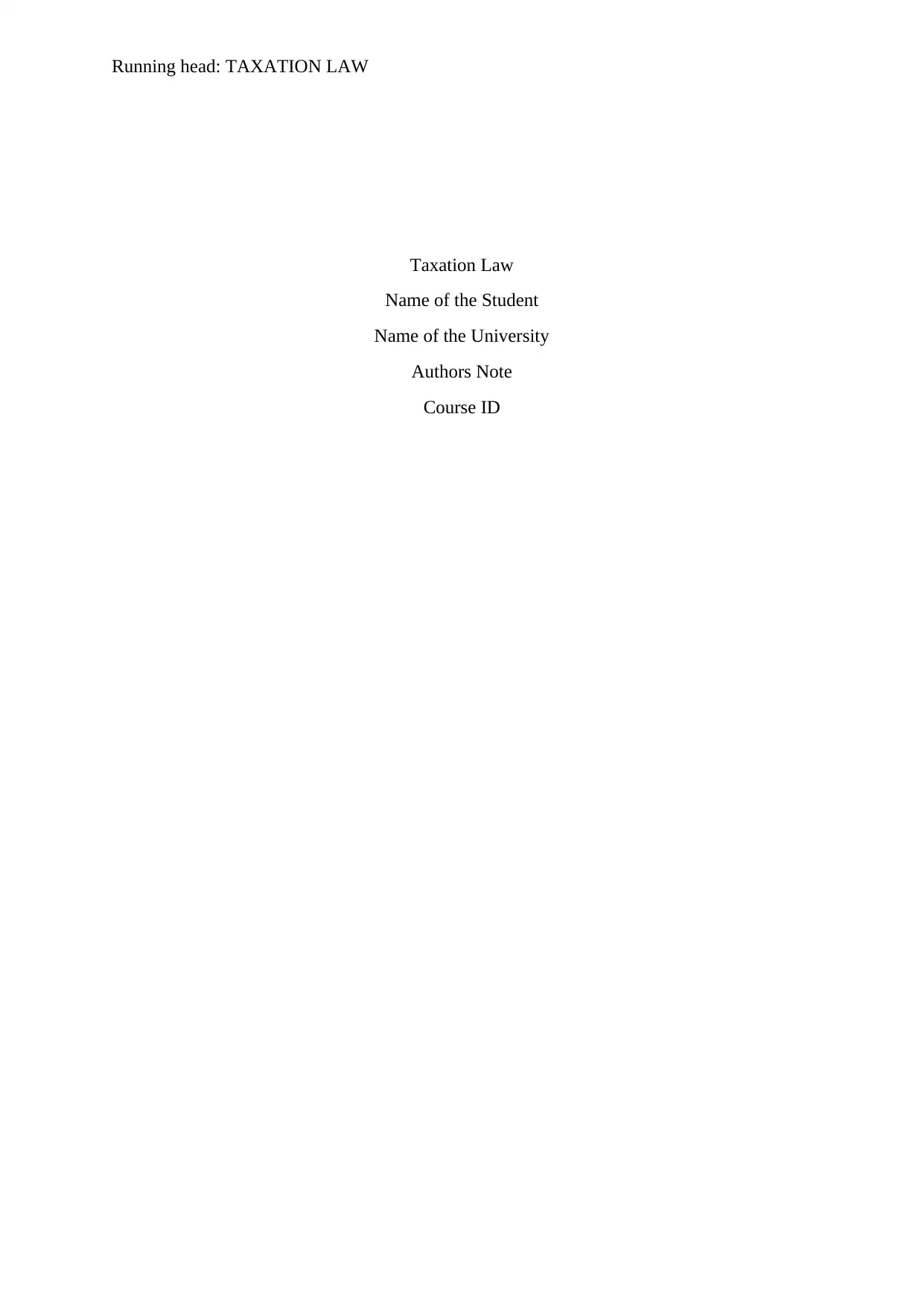
Running head: TAXATION LAW
Taxation Law
Name of the Student
Name of the University
Authors Note
Course ID
Taxation Law
Name of the Student
Name of the University
Authors Note
Course ID
Secure Best Marks with AI Grader
Need help grading? Try our AI Grader for instant feedback on your assignments.
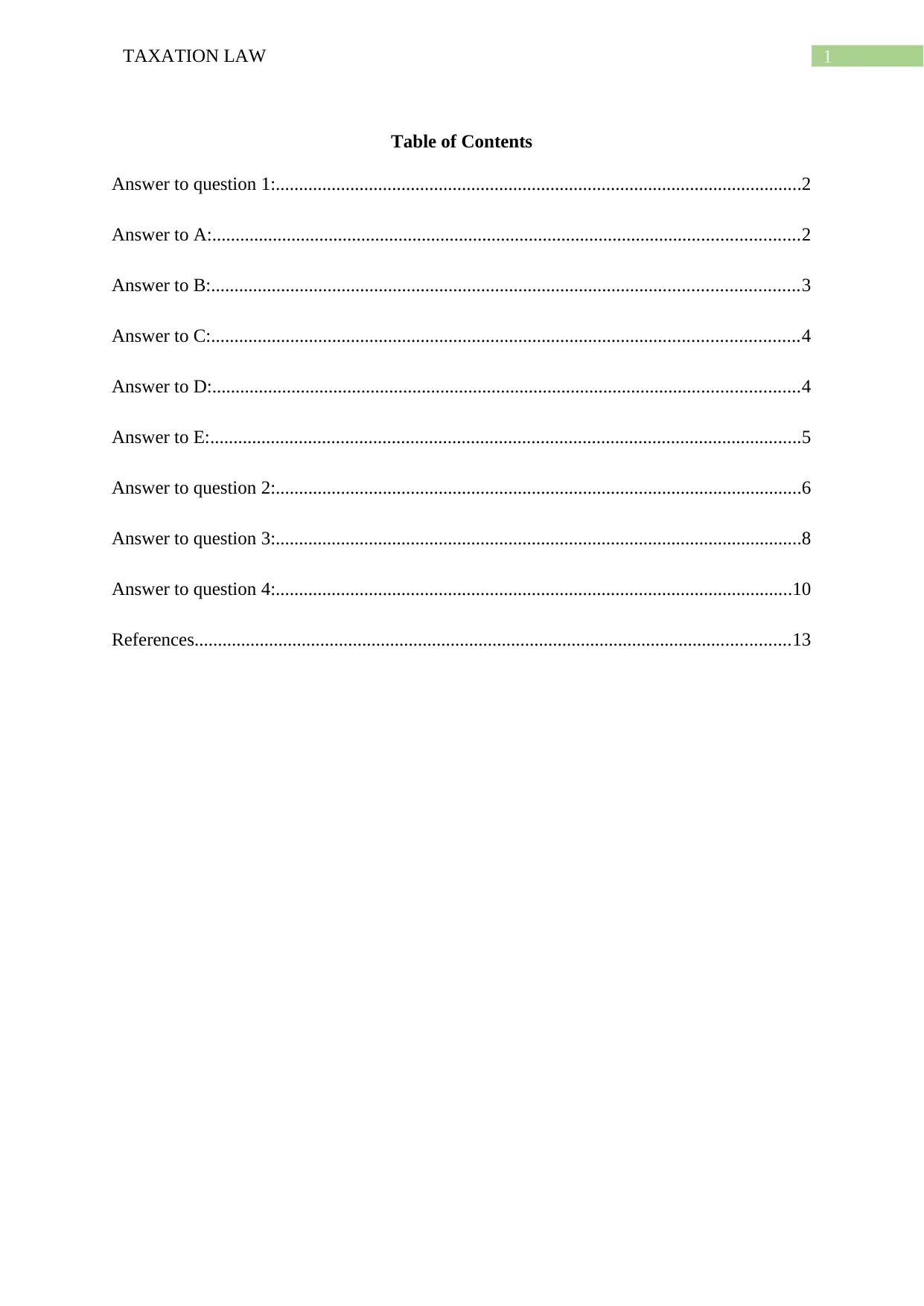
1TAXATION LAW
Table of Contents
Answer to question 1:.................................................................................................................2
Answer to A:..............................................................................................................................2
Answer to B:..............................................................................................................................3
Answer to C:..............................................................................................................................4
Answer to D:..............................................................................................................................4
Answer to E:...............................................................................................................................5
Answer to question 2:.................................................................................................................6
Answer to question 3:.................................................................................................................8
Answer to question 4:...............................................................................................................10
References................................................................................................................................13
Table of Contents
Answer to question 1:.................................................................................................................2
Answer to A:..............................................................................................................................2
Answer to B:..............................................................................................................................3
Answer to C:..............................................................................................................................4
Answer to D:..............................................................................................................................4
Answer to E:...............................................................................................................................5
Answer to question 2:.................................................................................................................6
Answer to question 3:.................................................................................................................8
Answer to question 4:...............................................................................................................10
References................................................................................................................................13

2TAXATION LAW
Answer to question 1:
Answer to A:
According to “Section 6-5 and 6-10 (3) of the ITAA 1997” a person is taken to have
obtained the sum when it is applied or dealt with in a manner on their behalf or as they direct.
“Subsection 6-2 (2) of the ITAA 1997” lay down that a person is assessable for income that
are derived directly sources or indirectly sources during the earnings year1. The “taxation
ruling of TR 2002/14” provides the situations where the large sum would be treated as
prepaid rent.
The “Taxation ruling of TR 2002/14” provides that a lump sum prepaid rent would
be held assessable if the intention of the parties represents that the large amount of
imbursement as an early payment is for an individual’s use and enjoyment of the residence
for the static term period2. As evident in the current situation the taxpayer owns a flat and
leases to same to a new tenant and received a prepaid lump sum of $15,000 for lease
negotiation. As held in the case of “Frezier v Commissioner of Stamp Duties (NSW)” the
taxation board stated that amount of prepaid lump sum was in fact the rent.3 The taxation
board held that the prepaid lump sum carried the nature of come home to the taxpayer and the
amount was fully assessable during the year of receipt. Referring to the Arthurs Case in the
1 Guner, Nezih, Remzi Kaygusuz, and Gustavo Ventura. "Income taxation of US households:
Facts and parametric estimates." Review of Economic Dynamics 17.4 (2014): 559-581.
2 Tanzi, Vito. "Inflation, indexation and interest income taxation." PSL Quarterly
Review 29.116 (2014).
3 McDaniel, Paul. Federal Income Taxation. Foundation Press, 2017.
Answer to question 1:
Answer to A:
According to “Section 6-5 and 6-10 (3) of the ITAA 1997” a person is taken to have
obtained the sum when it is applied or dealt with in a manner on their behalf or as they direct.
“Subsection 6-2 (2) of the ITAA 1997” lay down that a person is assessable for income that
are derived directly sources or indirectly sources during the earnings year1. The “taxation
ruling of TR 2002/14” provides the situations where the large sum would be treated as
prepaid rent.
The “Taxation ruling of TR 2002/14” provides that a lump sum prepaid rent would
be held assessable if the intention of the parties represents that the large amount of
imbursement as an early payment is for an individual’s use and enjoyment of the residence
for the static term period2. As evident in the current situation the taxpayer owns a flat and
leases to same to a new tenant and received a prepaid lump sum of $15,000 for lease
negotiation. As held in the case of “Frezier v Commissioner of Stamp Duties (NSW)” the
taxation board stated that amount of prepaid lump sum was in fact the rent.3 The taxation
board held that the prepaid lump sum carried the nature of come home to the taxpayer and the
amount was fully assessable during the year of receipt. Referring to the Arthurs Case in the
1 Guner, Nezih, Remzi Kaygusuz, and Gustavo Ventura. "Income taxation of US households:
Facts and parametric estimates." Review of Economic Dynamics 17.4 (2014): 559-581.
2 Tanzi, Vito. "Inflation, indexation and interest income taxation." PSL Quarterly
Review 29.116 (2014).
3 McDaniel, Paul. Federal Income Taxation. Foundation Press, 2017.

3TAXATION LAW
current situation, the receipt of prepaid lump sum of $15,000 by the landlord would be
included in his assessable income under section as income under regular impression.
Answer to B:
Insurance pay-outs is regarded as the entirely personal items that does not requires to
be included in their tax return4. However according to Australian taxation office receipts of
insurance payments for items that are used in the production of income might have to be
included in the taxable return. Given the circumstances that an individual receiving a lump
sum insurance payment to cover the assets, then the person is required to apportion the sum
of payment between the assets for the taxation purpose. As evident in the current situation the
Cheryl owned a warehouse that was demolished by fire and got a sum of $500,000 from the
insurance company as the compensation for the loss.
According to the judgement held in “Allied Mills Industries Pty Ltd v FCT (1989)”
the commissioner stated that the character of reimbursement incomes is reliant upon the sum
that is received5. Compensations generally represents a capital item unless in the situation of
substitution principle it replaces what was lost. It is worth mentioning that the loss of
employment the compensation payment would be considered as the income since it
represents the substitute for what was lost. In the current situation of Cheryl, the
compensation payment received by the insurance company constitutes a capital receipt as the
loss of warehouse by fire is a capital item6. Referring to above judgement the payment would
4 Bankman, Joseph, et al. Federal Income Taxation. Wolters Kluwer Law & Business, 2017.
5 Mares, Isabela, and Didac Queralt. "The non-democratic origins of income
taxation." Comparative Political Studies48.14 (2015): 1974-2009.
6 Geier, Deborah A. "US Federal Income Taxation of Individuals 2015." (2015).
current situation, the receipt of prepaid lump sum of $15,000 by the landlord would be
included in his assessable income under section as income under regular impression.
Answer to B:
Insurance pay-outs is regarded as the entirely personal items that does not requires to
be included in their tax return4. However according to Australian taxation office receipts of
insurance payments for items that are used in the production of income might have to be
included in the taxable return. Given the circumstances that an individual receiving a lump
sum insurance payment to cover the assets, then the person is required to apportion the sum
of payment between the assets for the taxation purpose. As evident in the current situation the
Cheryl owned a warehouse that was demolished by fire and got a sum of $500,000 from the
insurance company as the compensation for the loss.
According to the judgement held in “Allied Mills Industries Pty Ltd v FCT (1989)”
the commissioner stated that the character of reimbursement incomes is reliant upon the sum
that is received5. Compensations generally represents a capital item unless in the situation of
substitution principle it replaces what was lost. It is worth mentioning that the loss of
employment the compensation payment would be considered as the income since it
represents the substitute for what was lost. In the current situation of Cheryl, the
compensation payment received by the insurance company constitutes a capital receipt as the
loss of warehouse by fire is a capital item6. Referring to above judgement the payment would
4 Bankman, Joseph, et al. Federal Income Taxation. Wolters Kluwer Law & Business, 2017.
5 Mares, Isabela, and Didac Queralt. "The non-democratic origins of income
taxation." Comparative Political Studies48.14 (2015): 1974-2009.
6 Geier, Deborah A. "US Federal Income Taxation of Individuals 2015." (2015).
Secure Best Marks with AI Grader
Need help grading? Try our AI Grader for instant feedback on your assignments.

4TAXATION LAW
be regarded as the capital receiving and would not be included in the taxable proceeds of the
taxpayer.
Answer to C:
As per ATO an individual can claim a deduction for the expenditure they incur in
handling their tax return. The ATO provides that taxpayer can claim an allowable deduction
relating to the cost incurred in preparing and lodging their tax return. Evidently it is noticed
that Boris incurred an expenditure of $500 for the lodgement of his 2015-16 return7.
According to “section 8-1 of the ITAA 1997” a person would be allowed to claim an
allowable expenditure for the spending sustained in obtaining the calculable income. Boris
with respect to the guidelines of ATO will be permitted to claim an permissible deduction for
the expenditure sustained in making and lodging the tax return.
The ATO provides that an individual can consider lodging an objection regarding to
the conclusions about levy matters8. The charge that are incurred in raising the objections is
considered as an allowable deduction. Similarly in the case of Boris the spending sustained
by the taxpayer would be permissible for deductions under “section 8-1 of the ITAA 1997”.
7 Ábrahám, Árpád, Sebastian Koehne, and Nicola Pavoni. "Optimal income taxation when
asset taxation is limited." Journal of Public Economics 136 (2016): 14-29.
8 Chorvat, Terrence R., and W. Gavin Ekins. "The Effect of Income Taxation on Risky
Investment: An Experiment." (2017).
be regarded as the capital receiving and would not be included in the taxable proceeds of the
taxpayer.
Answer to C:
As per ATO an individual can claim a deduction for the expenditure they incur in
handling their tax return. The ATO provides that taxpayer can claim an allowable deduction
relating to the cost incurred in preparing and lodging their tax return. Evidently it is noticed
that Boris incurred an expenditure of $500 for the lodgement of his 2015-16 return7.
According to “section 8-1 of the ITAA 1997” a person would be allowed to claim an
allowable expenditure for the spending sustained in obtaining the calculable income. Boris
with respect to the guidelines of ATO will be permitted to claim an permissible deduction for
the expenditure sustained in making and lodging the tax return.
The ATO provides that an individual can consider lodging an objection regarding to
the conclusions about levy matters8. The charge that are incurred in raising the objections is
considered as an allowable deduction. Similarly in the case of Boris the spending sustained
by the taxpayer would be permissible for deductions under “section 8-1 of the ITAA 1997”.
7 Ábrahám, Árpád, Sebastian Koehne, and Nicola Pavoni. "Optimal income taxation when
asset taxation is limited." Journal of Public Economics 136 (2016): 14-29.
8 Chorvat, Terrence R., and W. Gavin Ekins. "The Effect of Income Taxation on Risky
Investment: An Experiment." (2017).

5TAXATION LAW
Answer to D:
According to “section 8-1 (2) (b) of the ITAA 1997” states that a person is not
allowed to entitlement permissible deduction for spending that are occurred person purpose9.
These expenditure does not meet the means of the positive limbs, or it is not deductible under
the second limb. In the current case study, it is noticed that James worked at the hospital and
purchases lunch in the café hospital and incurs an expenditure of $2000.
As held in “Lunney v FCT” the court stated that it is necessary to take account of the
necessary character of the loss or outgoings that is insufficient for the outgoing as the
essential prerequisite in the derivation of the taxable income10. In another example the court
of law denied the taxpayer deductions for expenses incurred in moving with his family to the
new home in another city due to its relocation of job. Similarly, in the case of James the
expenditure incurred in by him is private or domestic in nature therefore the meal expenditure
of $2000 is not deductible.
Answer to E:
According to the ATO to ascertain whether the food or drink delivered to the person
represents entertainment. As defined under “section 32-10 of the ITAA 1997” it clearly
shows that the purpose of treating food and drink taken in the situations as the business
entertainment irrespective of whether the business discussion or business transactions takes
9 Schmalbeck, Richard, Lawrence Zelenak, and Sarah B. Lawsky. Federal Income Taxation.
Wolters Kluwer Law & Business, 2015.
10 Apps, Patricia, Ngo Long, and Ray Rees. "Optimal piecewise linear income
taxation." Journal of Public Economic Theory16.4 (2014): 523-545.
Answer to D:
According to “section 8-1 (2) (b) of the ITAA 1997” states that a person is not
allowed to entitlement permissible deduction for spending that are occurred person purpose9.
These expenditure does not meet the means of the positive limbs, or it is not deductible under
the second limb. In the current case study, it is noticed that James worked at the hospital and
purchases lunch in the café hospital and incurs an expenditure of $2000.
As held in “Lunney v FCT” the court stated that it is necessary to take account of the
necessary character of the loss or outgoings that is insufficient for the outgoing as the
essential prerequisite in the derivation of the taxable income10. In another example the court
of law denied the taxpayer deductions for expenses incurred in moving with his family to the
new home in another city due to its relocation of job. Similarly, in the case of James the
expenditure incurred in by him is private or domestic in nature therefore the meal expenditure
of $2000 is not deductible.
Answer to E:
According to the ATO to ascertain whether the food or drink delivered to the person
represents entertainment. As defined under “section 32-10 of the ITAA 1997” it clearly
shows that the purpose of treating food and drink taken in the situations as the business
entertainment irrespective of whether the business discussion or business transactions takes
9 Schmalbeck, Richard, Lawrence Zelenak, and Sarah B. Lawsky. Federal Income Taxation.
Wolters Kluwer Law & Business, 2015.
10 Apps, Patricia, Ngo Long, and Ray Rees. "Optimal piecewise linear income
taxation." Journal of Public Economic Theory16.4 (2014): 523-545.
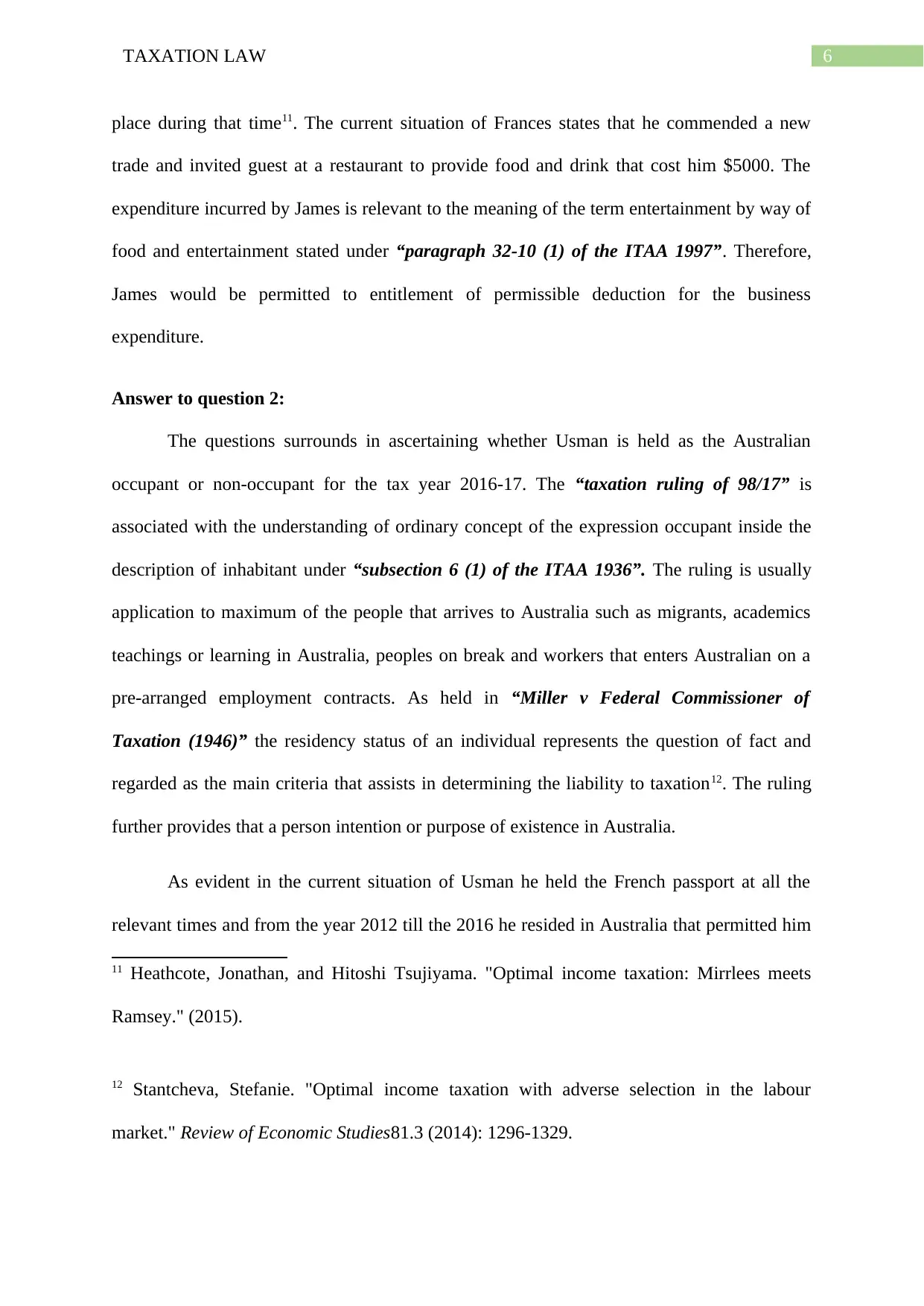
6TAXATION LAW
place during that time11. The current situation of Frances states that he commended a new
trade and invited guest at a restaurant to provide food and drink that cost him $5000. The
expenditure incurred by James is relevant to the meaning of the term entertainment by way of
food and entertainment stated under “paragraph 32-10 (1) of the ITAA 1997”. Therefore,
James would be permitted to entitlement of permissible deduction for the business
expenditure.
Answer to question 2:
The questions surrounds in ascertaining whether Usman is held as the Australian
occupant or non-occupant for the tax year 2016-17. The “taxation ruling of 98/17” is
associated with the understanding of ordinary concept of the expression occupant inside the
description of inhabitant under “subsection 6 (1) of the ITAA 1936”. The ruling is usually
application to maximum of the people that arrives to Australia such as migrants, academics
teachings or learning in Australia, peoples on break and workers that enters Australian on a
pre-arranged employment contracts. As held in “Miller v Federal Commissioner of
Taxation (1946)” the residency status of an individual represents the question of fact and
regarded as the main criteria that assists in determining the liability to taxation12. The ruling
further provides that a person intention or purpose of existence in Australia.
As evident in the current situation of Usman he held the French passport at all the
relevant times and from the year 2012 till the 2016 he resided in Australia that permitted him
11 Heathcote, Jonathan, and Hitoshi Tsujiyama. "Optimal income taxation: Mirrlees meets
Ramsey." (2015).
12 Stantcheva, Stefanie. "Optimal income taxation with adverse selection in the labour
market." Review of Economic Studies81.3 (2014): 1296-1329.
place during that time11. The current situation of Frances states that he commended a new
trade and invited guest at a restaurant to provide food and drink that cost him $5000. The
expenditure incurred by James is relevant to the meaning of the term entertainment by way of
food and entertainment stated under “paragraph 32-10 (1) of the ITAA 1997”. Therefore,
James would be permitted to entitlement of permissible deduction for the business
expenditure.
Answer to question 2:
The questions surrounds in ascertaining whether Usman is held as the Australian
occupant or non-occupant for the tax year 2016-17. The “taxation ruling of 98/17” is
associated with the understanding of ordinary concept of the expression occupant inside the
description of inhabitant under “subsection 6 (1) of the ITAA 1936”. The ruling is usually
application to maximum of the people that arrives to Australia such as migrants, academics
teachings or learning in Australia, peoples on break and workers that enters Australian on a
pre-arranged employment contracts. As held in “Miller v Federal Commissioner of
Taxation (1946)” the residency status of an individual represents the question of fact and
regarded as the main criteria that assists in determining the liability to taxation12. The ruling
further provides that a person intention or purpose of existence in Australia.
As evident in the current situation of Usman he held the French passport at all the
relevant times and from the year 2012 till the 2016 he resided in Australia that permitted him
11 Heathcote, Jonathan, and Hitoshi Tsujiyama. "Optimal income taxation: Mirrlees meets
Ramsey." (2015).
12 Stantcheva, Stefanie. "Optimal income taxation with adverse selection in the labour
market." Review of Economic Studies81.3 (2014): 1296-1329.
Paraphrase This Document
Need a fresh take? Get an instant paraphrase of this document with our AI Paraphraser
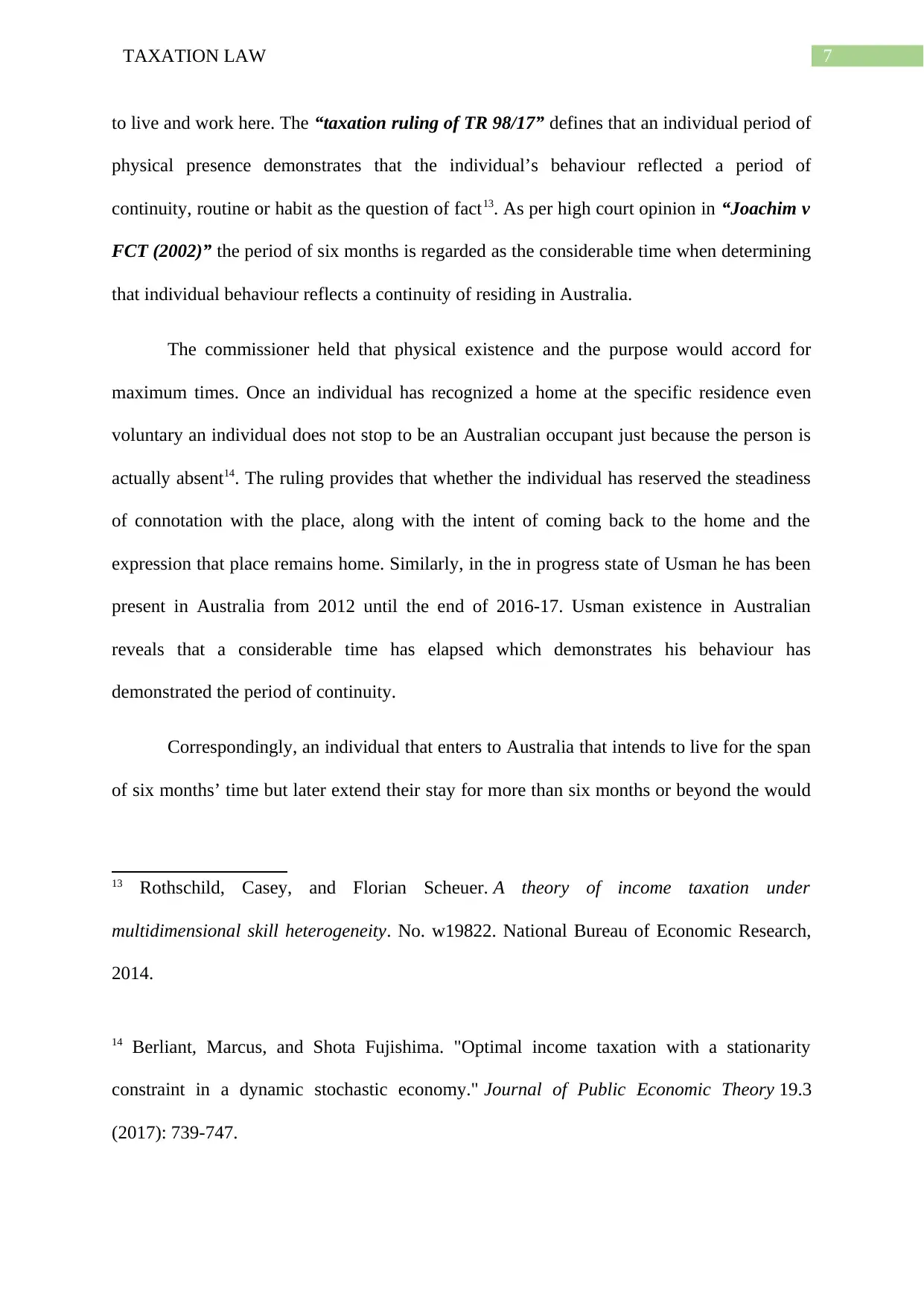
7TAXATION LAW
to live and work here. The “taxation ruling of TR 98/17” defines that an individual period of
physical presence demonstrates that the individual’s behaviour reflected a period of
continuity, routine or habit as the question of fact13. As per high court opinion in “Joachim v
FCT (2002)” the period of six months is regarded as the considerable time when determining
that individual behaviour reflects a continuity of residing in Australia.
The commissioner held that physical existence and the purpose would accord for
maximum times. Once an individual has recognized a home at the specific residence even
voluntary an individual does not stop to be an Australian occupant just because the person is
actually absent14. The ruling provides that whether the individual has reserved the steadiness
of connotation with the place, along with the intent of coming back to the home and the
expression that place remains home. Similarly, in the in progress state of Usman he has been
present in Australia from 2012 until the end of 2016-17. Usman existence in Australian
reveals that a considerable time has elapsed which demonstrates his behaviour has
demonstrated the period of continuity.
Correspondingly, an individual that enters to Australia that intends to live for the span
of six months’ time but later extend their stay for more than six months or beyond the would
13 Rothschild, Casey, and Florian Scheuer. A theory of income taxation under
multidimensional skill heterogeneity. No. w19822. National Bureau of Economic Research,
2014.
14 Berliant, Marcus, and Shota Fujishima. "Optimal income taxation with a stationarity
constraint in a dynamic stochastic economy." Journal of Public Economic Theory 19.3
(2017): 739-747.
to live and work here. The “taxation ruling of TR 98/17” defines that an individual period of
physical presence demonstrates that the individual’s behaviour reflected a period of
continuity, routine or habit as the question of fact13. As per high court opinion in “Joachim v
FCT (2002)” the period of six months is regarded as the considerable time when determining
that individual behaviour reflects a continuity of residing in Australia.
The commissioner held that physical existence and the purpose would accord for
maximum times. Once an individual has recognized a home at the specific residence even
voluntary an individual does not stop to be an Australian occupant just because the person is
actually absent14. The ruling provides that whether the individual has reserved the steadiness
of connotation with the place, along with the intent of coming back to the home and the
expression that place remains home. Similarly, in the in progress state of Usman he has been
present in Australia from 2012 until the end of 2016-17. Usman existence in Australian
reveals that a considerable time has elapsed which demonstrates his behaviour has
demonstrated the period of continuity.
Correspondingly, an individual that enters to Australia that intends to live for the span
of six months’ time but later extend their stay for more than six months or beyond the would
13 Rothschild, Casey, and Florian Scheuer. A theory of income taxation under
multidimensional skill heterogeneity. No. w19822. National Bureau of Economic Research,
2014.
14 Berliant, Marcus, and Shota Fujishima. "Optimal income taxation with a stationarity
constraint in a dynamic stochastic economy." Journal of Public Economic Theory 19.3
(2017): 739-747.
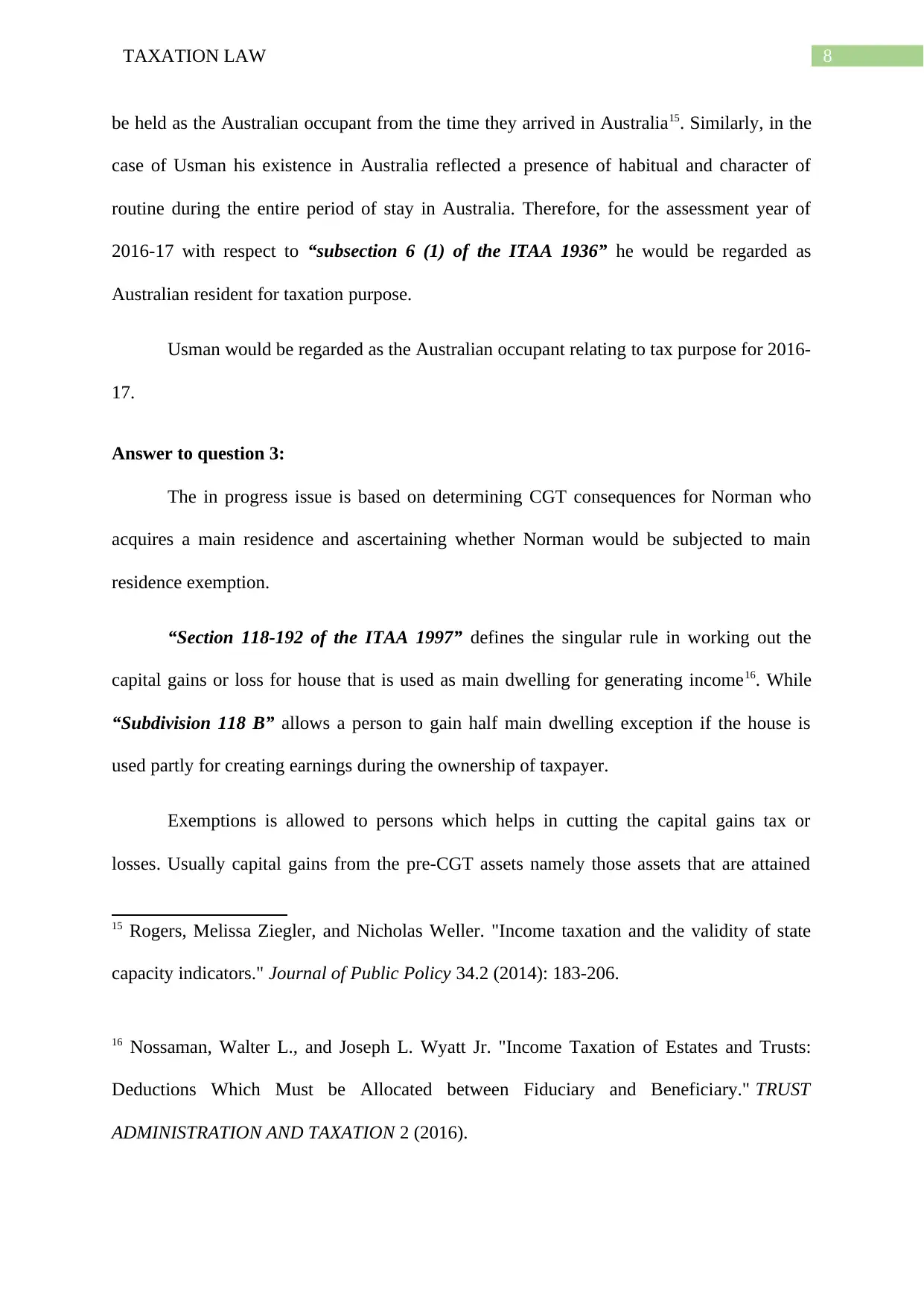
8TAXATION LAW
be held as the Australian occupant from the time they arrived in Australia15. Similarly, in the
case of Usman his existence in Australia reflected a presence of habitual and character of
routine during the entire period of stay in Australia. Therefore, for the assessment year of
2016-17 with respect to “subsection 6 (1) of the ITAA 1936” he would be regarded as
Australian resident for taxation purpose.
Usman would be regarded as the Australian occupant relating to tax purpose for 2016-
17.
Answer to question 3:
The in progress issue is based on determining CGT consequences for Norman who
acquires a main residence and ascertaining whether Norman would be subjected to main
residence exemption.
“Section 118-192 of the ITAA 1997” defines the singular rule in working out the
capital gains or loss for house that is used as main dwelling for generating income16. While
“Subdivision 118 B” allows a person to gain half main dwelling exception if the house is
used partly for creating earnings during the ownership of taxpayer.
Exemptions is allowed to persons which helps in cutting the capital gains tax or
losses. Usually capital gains from the pre-CGT assets namely those assets that are attained
15 Rogers, Melissa Ziegler, and Nicholas Weller. "Income taxation and the validity of state
capacity indicators." Journal of Public Policy 34.2 (2014): 183-206.
16 Nossaman, Walter L., and Joseph L. Wyatt Jr. "Income Taxation of Estates and Trusts:
Deductions Which Must be Allocated between Fiduciary and Beneficiary." TRUST
ADMINISTRATION AND TAXATION 2 (2016).
be held as the Australian occupant from the time they arrived in Australia15. Similarly, in the
case of Usman his existence in Australia reflected a presence of habitual and character of
routine during the entire period of stay in Australia. Therefore, for the assessment year of
2016-17 with respect to “subsection 6 (1) of the ITAA 1936” he would be regarded as
Australian resident for taxation purpose.
Usman would be regarded as the Australian occupant relating to tax purpose for 2016-
17.
Answer to question 3:
The in progress issue is based on determining CGT consequences for Norman who
acquires a main residence and ascertaining whether Norman would be subjected to main
residence exemption.
“Section 118-192 of the ITAA 1997” defines the singular rule in working out the
capital gains or loss for house that is used as main dwelling for generating income16. While
“Subdivision 118 B” allows a person to gain half main dwelling exception if the house is
used partly for creating earnings during the ownership of taxpayer.
Exemptions is allowed to persons which helps in cutting the capital gains tax or
losses. Usually capital gains from the pre-CGT assets namely those assets that are attained
15 Rogers, Melissa Ziegler, and Nicholas Weller. "Income taxation and the validity of state
capacity indicators." Journal of Public Policy 34.2 (2014): 183-206.
16 Nossaman, Walter L., and Joseph L. Wyatt Jr. "Income Taxation of Estates and Trusts:
Deductions Which Must be Allocated between Fiduciary and Beneficiary." TRUST
ADMINISTRATION AND TAXATION 2 (2016).
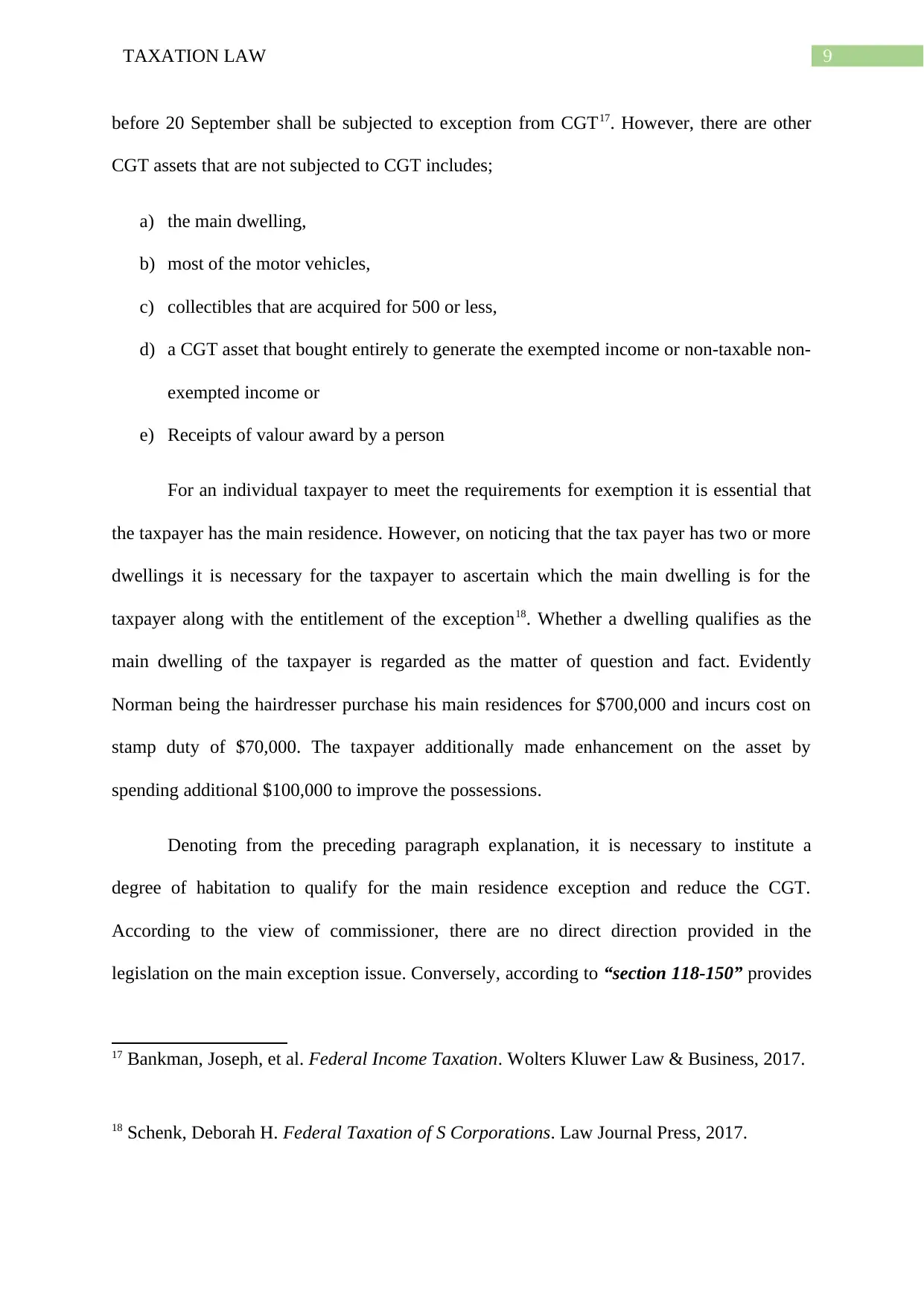
9TAXATION LAW
before 20 September shall be subjected to exception from CGT17. However, there are other
CGT assets that are not subjected to CGT includes;
a) the main dwelling,
b) most of the motor vehicles,
c) collectibles that are acquired for 500 or less,
d) a CGT asset that bought entirely to generate the exempted income or non-taxable non-
exempted income or
e) Receipts of valour award by a person
For an individual taxpayer to meet the requirements for exemption it is essential that
the taxpayer has the main residence. However, on noticing that the tax payer has two or more
dwellings it is necessary for the taxpayer to ascertain which the main dwelling is for the
taxpayer along with the entitlement of the exception18. Whether a dwelling qualifies as the
main dwelling of the taxpayer is regarded as the matter of question and fact. Evidently
Norman being the hairdresser purchase his main residences for $700,000 and incurs cost on
stamp duty of $70,000. The taxpayer additionally made enhancement on the asset by
spending additional $100,000 to improve the possessions.
Denoting from the preceding paragraph explanation, it is necessary to institute a
degree of habitation to qualify for the main residence exception and reduce the CGT.
According to the view of commissioner, there are no direct direction provided in the
legislation on the main exception issue. Conversely, according to “section 118-150” provides
17 Bankman, Joseph, et al. Federal Income Taxation. Wolters Kluwer Law & Business, 2017.
18 Schenk, Deborah H. Federal Taxation of S Corporations. Law Journal Press, 2017.
before 20 September shall be subjected to exception from CGT17. However, there are other
CGT assets that are not subjected to CGT includes;
a) the main dwelling,
b) most of the motor vehicles,
c) collectibles that are acquired for 500 or less,
d) a CGT asset that bought entirely to generate the exempted income or non-taxable non-
exempted income or
e) Receipts of valour award by a person
For an individual taxpayer to meet the requirements for exemption it is essential that
the taxpayer has the main residence. However, on noticing that the tax payer has two or more
dwellings it is necessary for the taxpayer to ascertain which the main dwelling is for the
taxpayer along with the entitlement of the exception18. Whether a dwelling qualifies as the
main dwelling of the taxpayer is regarded as the matter of question and fact. Evidently
Norman being the hairdresser purchase his main residences for $700,000 and incurs cost on
stamp duty of $70,000. The taxpayer additionally made enhancement on the asset by
spending additional $100,000 to improve the possessions.
Denoting from the preceding paragraph explanation, it is necessary to institute a
degree of habitation to qualify for the main residence exception and reduce the CGT.
According to the view of commissioner, there are no direct direction provided in the
legislation on the main exception issue. Conversely, according to “section 118-150” provides
17 Bankman, Joseph, et al. Federal Income Taxation. Wolters Kluwer Law & Business, 2017.
18 Schenk, Deborah H. Federal Taxation of S Corporations. Law Journal Press, 2017.
Secure Best Marks with AI Grader
Need help grading? Try our AI Grader for instant feedback on your assignments.
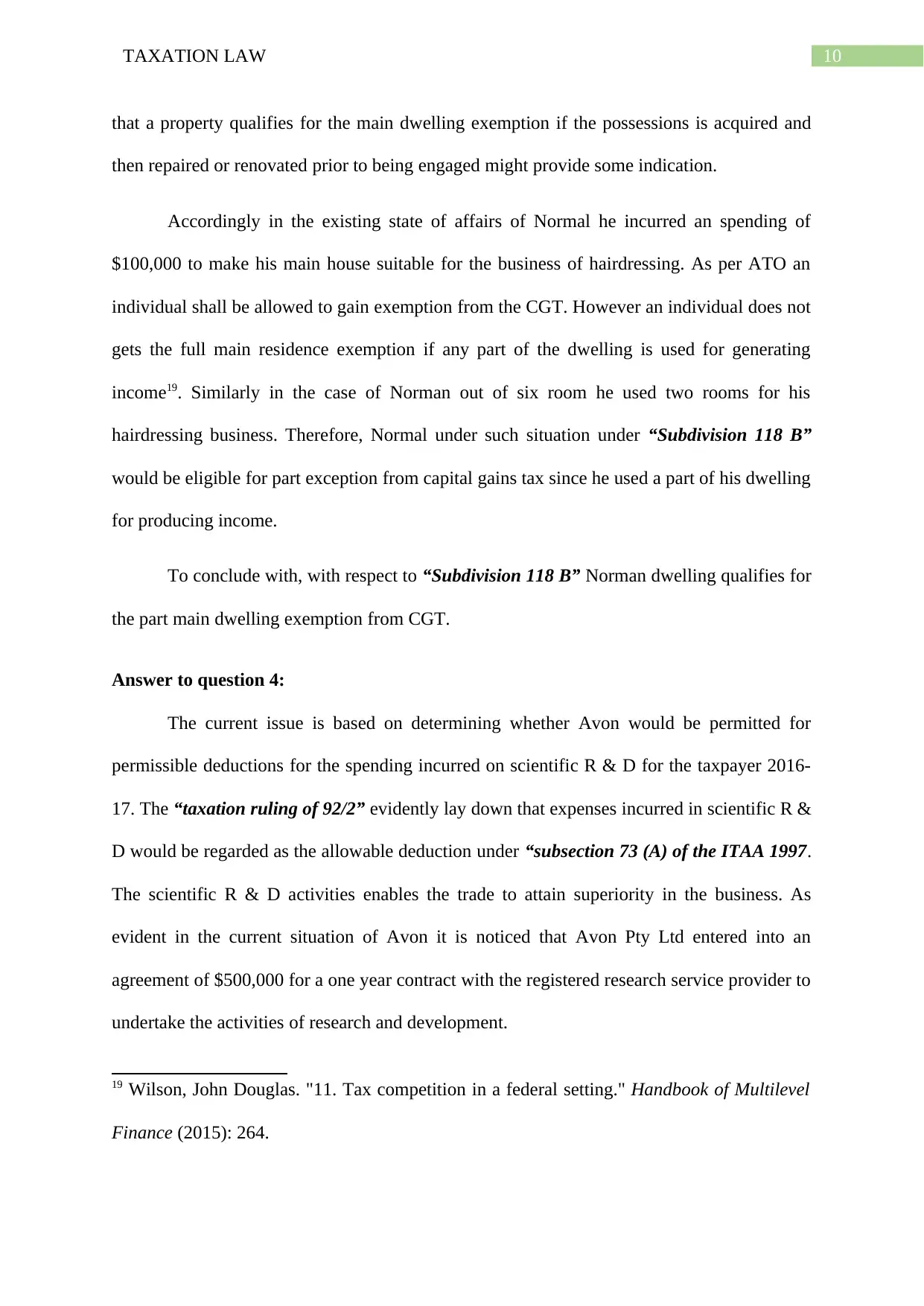
10TAXATION LAW
that a property qualifies for the main dwelling exemption if the possessions is acquired and
then repaired or renovated prior to being engaged might provide some indication.
Accordingly in the existing state of affairs of Normal he incurred an spending of
$100,000 to make his main house suitable for the business of hairdressing. As per ATO an
individual shall be allowed to gain exemption from the CGT. However an individual does not
gets the full main residence exemption if any part of the dwelling is used for generating
income19. Similarly in the case of Norman out of six room he used two rooms for his
hairdressing business. Therefore, Normal under such situation under “Subdivision 118 B”
would be eligible for part exception from capital gains tax since he used a part of his dwelling
for producing income.
To conclude with, with respect to “Subdivision 118 B” Norman dwelling qualifies for
the part main dwelling exemption from CGT.
Answer to question 4:
The current issue is based on determining whether Avon would be permitted for
permissible deductions for the spending incurred on scientific R & D for the taxpayer 2016-
17. The “taxation ruling of 92/2” evidently lay down that expenses incurred in scientific R &
D would be regarded as the allowable deduction under “subsection 73 (A) of the ITAA 1997.
The scientific R & D activities enables the trade to attain superiority in the business. As
evident in the current situation of Avon it is noticed that Avon Pty Ltd entered into an
agreement of $500,000 for a one year contract with the registered research service provider to
undertake the activities of research and development.
19 Wilson, John Douglas. "11. Tax competition in a federal setting." Handbook of Multilevel
Finance (2015): 264.
that a property qualifies for the main dwelling exemption if the possessions is acquired and
then repaired or renovated prior to being engaged might provide some indication.
Accordingly in the existing state of affairs of Normal he incurred an spending of
$100,000 to make his main house suitable for the business of hairdressing. As per ATO an
individual shall be allowed to gain exemption from the CGT. However an individual does not
gets the full main residence exemption if any part of the dwelling is used for generating
income19. Similarly in the case of Norman out of six room he used two rooms for his
hairdressing business. Therefore, Normal under such situation under “Subdivision 118 B”
would be eligible for part exception from capital gains tax since he used a part of his dwelling
for producing income.
To conclude with, with respect to “Subdivision 118 B” Norman dwelling qualifies for
the part main dwelling exemption from CGT.
Answer to question 4:
The current issue is based on determining whether Avon would be permitted for
permissible deductions for the spending incurred on scientific R & D for the taxpayer 2016-
17. The “taxation ruling of 92/2” evidently lay down that expenses incurred in scientific R &
D would be regarded as the allowable deduction under “subsection 73 (A) of the ITAA 1997.
The scientific R & D activities enables the trade to attain superiority in the business. As
evident in the current situation of Avon it is noticed that Avon Pty Ltd entered into an
agreement of $500,000 for a one year contract with the registered research service provider to
undertake the activities of research and development.
19 Wilson, John Douglas. "11. Tax competition in a federal setting." Handbook of Multilevel
Finance (2015): 264.

11TAXATION LAW
Considering the current situation of Avon an assistance can be made by affirming that
under “section 73A of ITAA 1997” allows an organization to bring its claim for deductions
in tax relating to expenses incurred on scientific research and development which may not be
permissible under any additional provision20. A noteworthy consideration has been laid down
under “section 73A of ITAA, 1936” that an organization is allowed to claim an allowable
deductions for scientific R & D only if the expenditure is occurred in generating assessable
income. If an organization is found to have incurred scientific R & D that is directed in the
direction of deriving taxable income then an organization is denied deductions this ruling.
Furthermore “subsection 1 of the section 73A of the ITAA 1936” provides that an
organization would be only allowed to claim an allowable deduction for expenditure on
research and development if the expenses is incurred or payments made to the approved
research institutes.
As understood from the analysis the payment made by Avon Pty Ltd to Central
Queensland University which is an approved provider for research and development is
assumed to be related to the business activities of taxpayer. Therefore, Avon Pty ltd would be
able to gain an allowable deductions from the assessable income for the research and
development expenditure incurred.
Under “section 73A of ITAA, 1936” of the “taxation ruling of TR 92/2” an
organization is also provided with the tax incentive relating to the expenditure occurred on
scientific research and development from the approved institute. However, “Section 73A of
the ITAA 1997” provides that to avail the tax incentive an organization is required to meet
the obligatory requirements for deductions.
20 Lockwood, Benjamin B. Optimal income taxation with present bias. University of
Pennsylvania Working Paper, 2016.
Considering the current situation of Avon an assistance can be made by affirming that
under “section 73A of ITAA 1997” allows an organization to bring its claim for deductions
in tax relating to expenses incurred on scientific research and development which may not be
permissible under any additional provision20. A noteworthy consideration has been laid down
under “section 73A of ITAA, 1936” that an organization is allowed to claim an allowable
deductions for scientific R & D only if the expenditure is occurred in generating assessable
income. If an organization is found to have incurred scientific R & D that is directed in the
direction of deriving taxable income then an organization is denied deductions this ruling.
Furthermore “subsection 1 of the section 73A of the ITAA 1936” provides that an
organization would be only allowed to claim an allowable deduction for expenditure on
research and development if the expenses is incurred or payments made to the approved
research institutes.
As understood from the analysis the payment made by Avon Pty Ltd to Central
Queensland University which is an approved provider for research and development is
assumed to be related to the business activities of taxpayer. Therefore, Avon Pty ltd would be
able to gain an allowable deductions from the assessable income for the research and
development expenditure incurred.
Under “section 73A of ITAA, 1936” of the “taxation ruling of TR 92/2” an
organization is also provided with the tax incentive relating to the expenditure occurred on
scientific research and development from the approved institute. However, “Section 73A of
the ITAA 1997” provides that to avail the tax incentive an organization is required to meet
the obligatory requirements for deductions.
20 Lockwood, Benjamin B. Optimal income taxation with present bias. University of
Pennsylvania Working Paper, 2016.
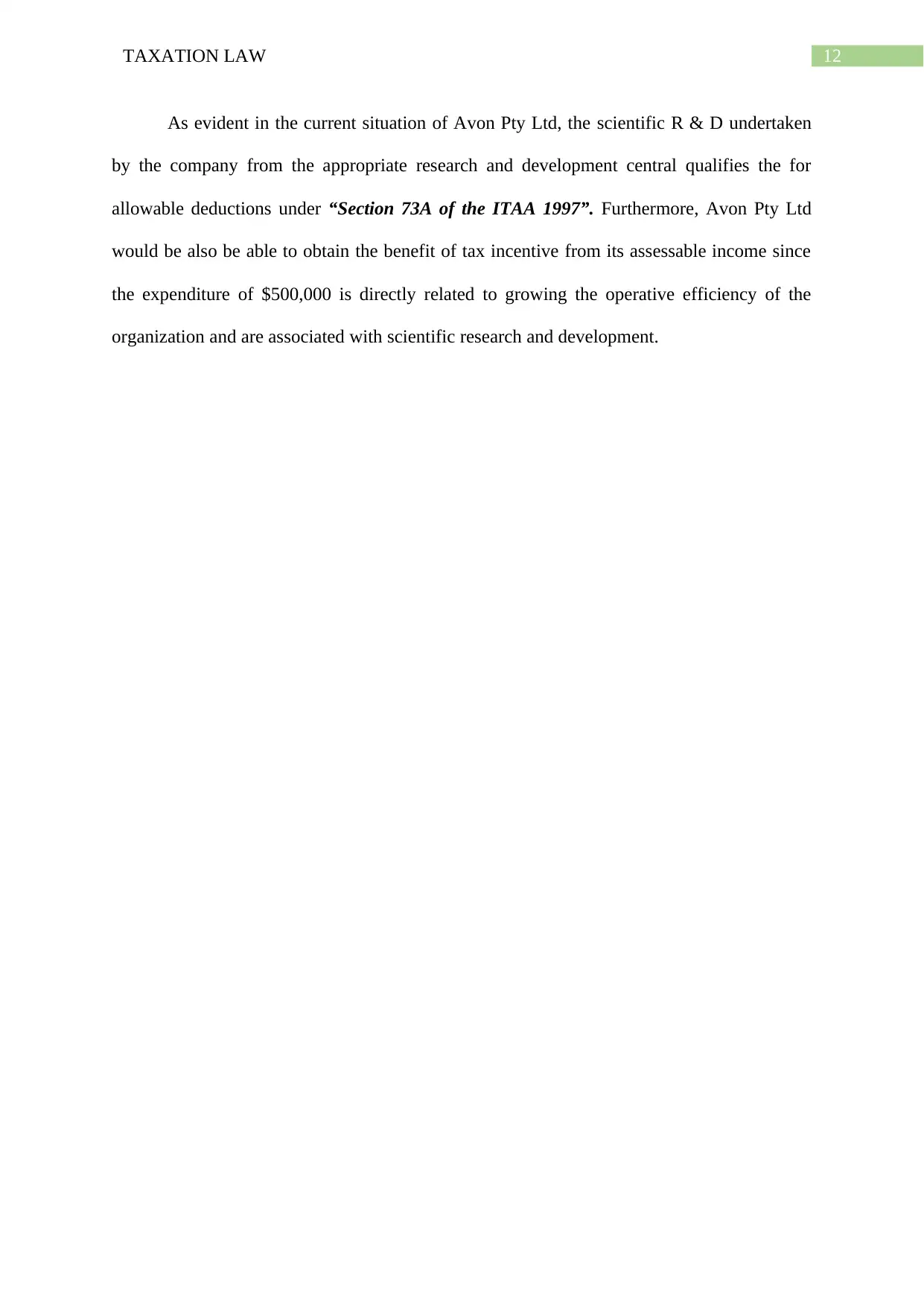
12TAXATION LAW
As evident in the current situation of Avon Pty Ltd, the scientific R & D undertaken
by the company from the appropriate research and development central qualifies the for
allowable deductions under “Section 73A of the ITAA 1997”. Furthermore, Avon Pty Ltd
would be also be able to obtain the benefit of tax incentive from its assessable income since
the expenditure of $500,000 is directly related to growing the operative efficiency of the
organization and are associated with scientific research and development.
As evident in the current situation of Avon Pty Ltd, the scientific R & D undertaken
by the company from the appropriate research and development central qualifies the for
allowable deductions under “Section 73A of the ITAA 1997”. Furthermore, Avon Pty Ltd
would be also be able to obtain the benefit of tax incentive from its assessable income since
the expenditure of $500,000 is directly related to growing the operative efficiency of the
organization and are associated with scientific research and development.
Paraphrase This Document
Need a fresh take? Get an instant paraphrase of this document with our AI Paraphraser
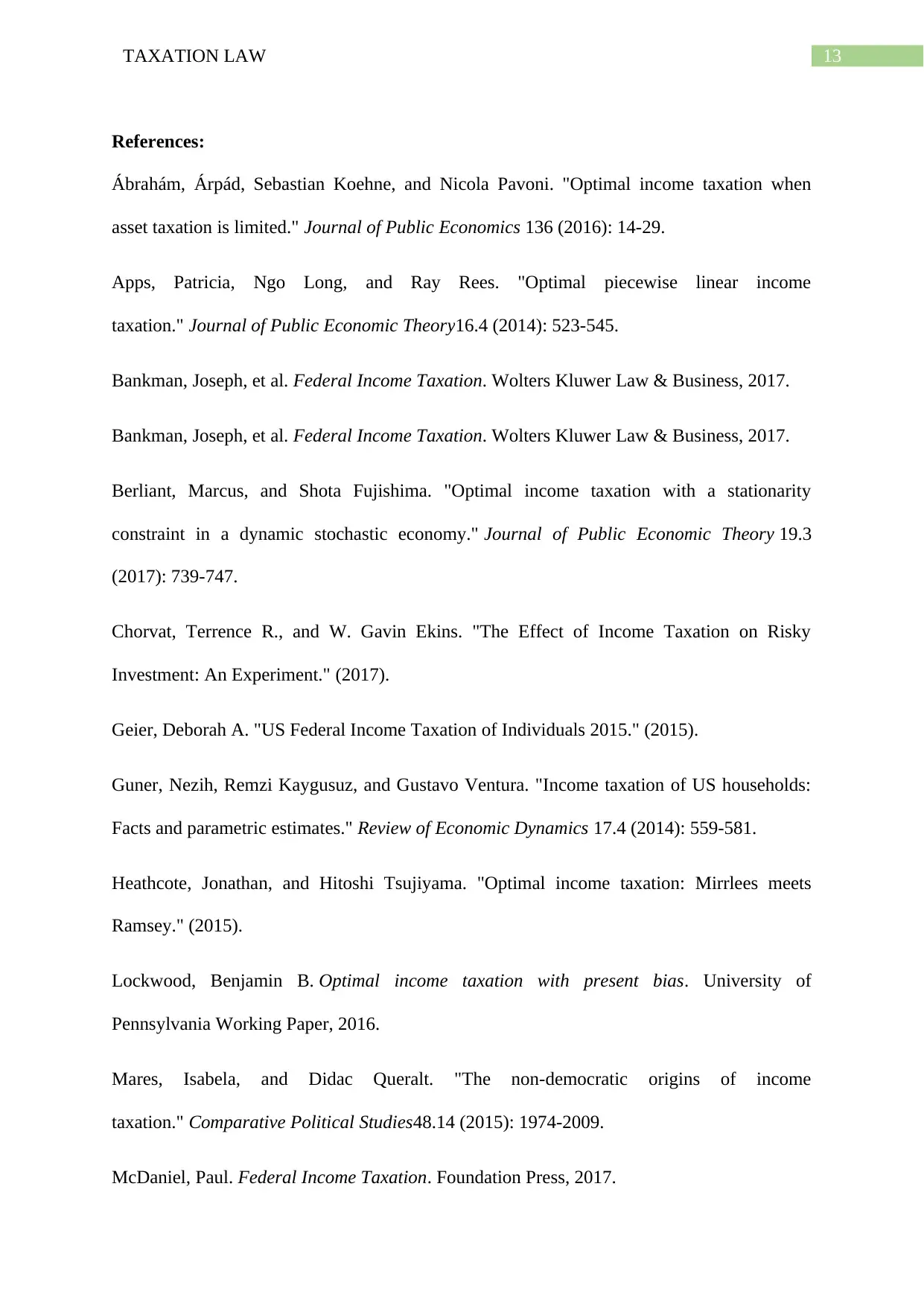
13TAXATION LAW
References:
Ábrahám, Árpád, Sebastian Koehne, and Nicola Pavoni. "Optimal income taxation when
asset taxation is limited." Journal of Public Economics 136 (2016): 14-29.
Apps, Patricia, Ngo Long, and Ray Rees. "Optimal piecewise linear income
taxation." Journal of Public Economic Theory16.4 (2014): 523-545.
Bankman, Joseph, et al. Federal Income Taxation. Wolters Kluwer Law & Business, 2017.
Bankman, Joseph, et al. Federal Income Taxation. Wolters Kluwer Law & Business, 2017.
Berliant, Marcus, and Shota Fujishima. "Optimal income taxation with a stationarity
constraint in a dynamic stochastic economy." Journal of Public Economic Theory 19.3
(2017): 739-747.
Chorvat, Terrence R., and W. Gavin Ekins. "The Effect of Income Taxation on Risky
Investment: An Experiment." (2017).
Geier, Deborah A. "US Federal Income Taxation of Individuals 2015." (2015).
Guner, Nezih, Remzi Kaygusuz, and Gustavo Ventura. "Income taxation of US households:
Facts and parametric estimates." Review of Economic Dynamics 17.4 (2014): 559-581.
Heathcote, Jonathan, and Hitoshi Tsujiyama. "Optimal income taxation: Mirrlees meets
Ramsey." (2015).
Lockwood, Benjamin B. Optimal income taxation with present bias. University of
Pennsylvania Working Paper, 2016.
Mares, Isabela, and Didac Queralt. "The non-democratic origins of income
taxation." Comparative Political Studies48.14 (2015): 1974-2009.
McDaniel, Paul. Federal Income Taxation. Foundation Press, 2017.
References:
Ábrahám, Árpád, Sebastian Koehne, and Nicola Pavoni. "Optimal income taxation when
asset taxation is limited." Journal of Public Economics 136 (2016): 14-29.
Apps, Patricia, Ngo Long, and Ray Rees. "Optimal piecewise linear income
taxation." Journal of Public Economic Theory16.4 (2014): 523-545.
Bankman, Joseph, et al. Federal Income Taxation. Wolters Kluwer Law & Business, 2017.
Bankman, Joseph, et al. Federal Income Taxation. Wolters Kluwer Law & Business, 2017.
Berliant, Marcus, and Shota Fujishima. "Optimal income taxation with a stationarity
constraint in a dynamic stochastic economy." Journal of Public Economic Theory 19.3
(2017): 739-747.
Chorvat, Terrence R., and W. Gavin Ekins. "The Effect of Income Taxation on Risky
Investment: An Experiment." (2017).
Geier, Deborah A. "US Federal Income Taxation of Individuals 2015." (2015).
Guner, Nezih, Remzi Kaygusuz, and Gustavo Ventura. "Income taxation of US households:
Facts and parametric estimates." Review of Economic Dynamics 17.4 (2014): 559-581.
Heathcote, Jonathan, and Hitoshi Tsujiyama. "Optimal income taxation: Mirrlees meets
Ramsey." (2015).
Lockwood, Benjamin B. Optimal income taxation with present bias. University of
Pennsylvania Working Paper, 2016.
Mares, Isabela, and Didac Queralt. "The non-democratic origins of income
taxation." Comparative Political Studies48.14 (2015): 1974-2009.
McDaniel, Paul. Federal Income Taxation. Foundation Press, 2017.
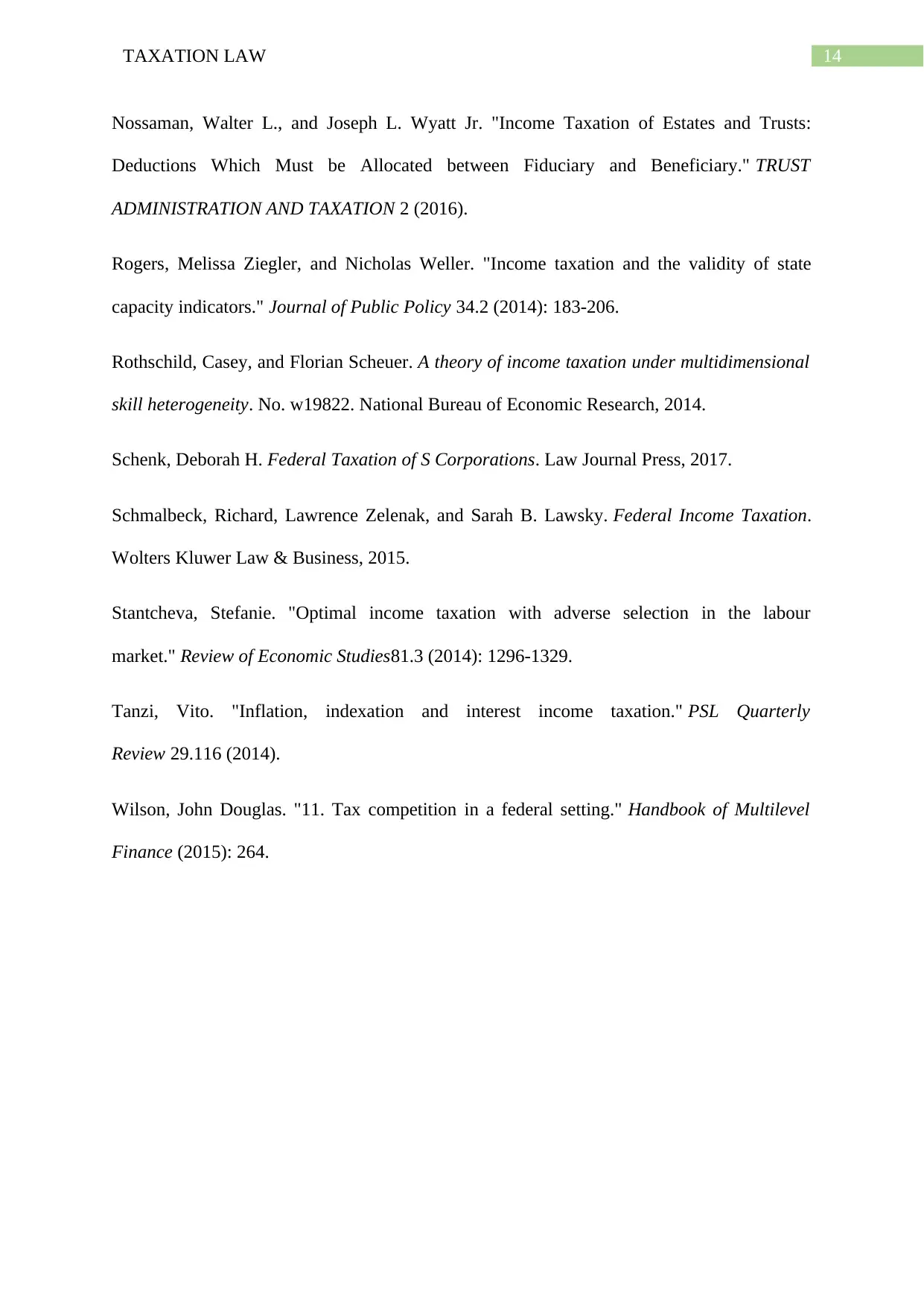
14TAXATION LAW
Nossaman, Walter L., and Joseph L. Wyatt Jr. "Income Taxation of Estates and Trusts:
Deductions Which Must be Allocated between Fiduciary and Beneficiary." TRUST
ADMINISTRATION AND TAXATION 2 (2016).
Rogers, Melissa Ziegler, and Nicholas Weller. "Income taxation and the validity of state
capacity indicators." Journal of Public Policy 34.2 (2014): 183-206.
Rothschild, Casey, and Florian Scheuer. A theory of income taxation under multidimensional
skill heterogeneity. No. w19822. National Bureau of Economic Research, 2014.
Schenk, Deborah H. Federal Taxation of S Corporations. Law Journal Press, 2017.
Schmalbeck, Richard, Lawrence Zelenak, and Sarah B. Lawsky. Federal Income Taxation.
Wolters Kluwer Law & Business, 2015.
Stantcheva, Stefanie. "Optimal income taxation with adverse selection in the labour
market." Review of Economic Studies81.3 (2014): 1296-1329.
Tanzi, Vito. "Inflation, indexation and interest income taxation." PSL Quarterly
Review 29.116 (2014).
Wilson, John Douglas. "11. Tax competition in a federal setting." Handbook of Multilevel
Finance (2015): 264.
Nossaman, Walter L., and Joseph L. Wyatt Jr. "Income Taxation of Estates and Trusts:
Deductions Which Must be Allocated between Fiduciary and Beneficiary." TRUST
ADMINISTRATION AND TAXATION 2 (2016).
Rogers, Melissa Ziegler, and Nicholas Weller. "Income taxation and the validity of state
capacity indicators." Journal of Public Policy 34.2 (2014): 183-206.
Rothschild, Casey, and Florian Scheuer. A theory of income taxation under multidimensional
skill heterogeneity. No. w19822. National Bureau of Economic Research, 2014.
Schenk, Deborah H. Federal Taxation of S Corporations. Law Journal Press, 2017.
Schmalbeck, Richard, Lawrence Zelenak, and Sarah B. Lawsky. Federal Income Taxation.
Wolters Kluwer Law & Business, 2015.
Stantcheva, Stefanie. "Optimal income taxation with adverse selection in the labour
market." Review of Economic Studies81.3 (2014): 1296-1329.
Tanzi, Vito. "Inflation, indexation and interest income taxation." PSL Quarterly
Review 29.116 (2014).
Wilson, John Douglas. "11. Tax competition in a federal setting." Handbook of Multilevel
Finance (2015): 264.
1 out of 15
Related Documents
Your All-in-One AI-Powered Toolkit for Academic Success.
+13062052269
info@desklib.com
Available 24*7 on WhatsApp / Email
![[object Object]](/_next/static/media/star-bottom.7253800d.svg)
Unlock your academic potential
© 2024 | Zucol Services PVT LTD | All rights reserved.



